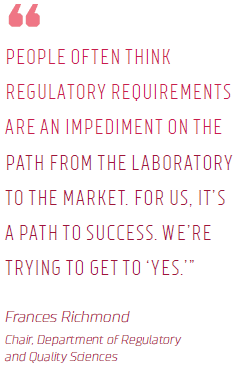Bright red letters spelling out “Yes” adorn Frances Richmond’s office in the Center for Health Professions Building on the USC Health Sciences Campus. They aptly represent her welcoming approach to students, collaborators and industry — as well as her philosophy on the field she helped pioneer.
Richmond launched the International Center for Regulatory Science at USC in 2012 after establishing the school’s regulatory science program in 1999. She created the first professional doctorate in regulatory science at USC in 2008. In May 2017, she became the inaugural chair of the school’s new Department of Regulatory and Quality Sciences. She earned a PhD in neurophysiology from Queen’s University in Ontario, where she later served as associate dean of life sciences. She was the first woman appointed a director of a research consortium funded by Canada’s Medical Research Council.
Here, she shares insights into the growing demand for regulatory science professionals, the need for a culture shift and knowing when to push the envelope.
How did you get into this field?
In the 1980s, I was at Queen’s University in Canada, creating devices to stimulate paralyzed muscles. To get an implantable device on the market requires a lot of testing and work with government agencies. Back then, however, you had the luxury of gradually becoming a regulatory expert over years. Today, not only are the science and quantitative methods more advanced and complex, but laws and regulations also are far more numerous.
 What led you to launch a regulatory science program?
What led you to launch a regulatory science program?
The stats on the number of PhD students who will get jobs in academia is about the same as for people who want to be professional footballers: not great. At Queen’s University, I oversaw a number of programs, and we had amazing PhD students. But there was a lot of sensitivity around the fact that they were not trained for anything but academic careers, and not enough of those jobs existed. Then, when I was in industry, I saw that many positions went vacant or were filled by mismatched people who didn’t have the appropriate training. That seemed like a disconnect that was easy to fix. So when I arrived at USC, I started the master’s programs to provide the transitional learning and additional skill sets to help science-trained students go into these jobs where expertise is so badly needed.
What distinguishes the USC program from newer programs?
I think ours is the sturdiest program in that we have the most full-time faculty, the only doctoral program in the U.S., and a strong combination of classroom and distance-based offerings. And we pride ourselves on going beyond the coursework to focus on the whole person.
Tell me more about that.
I’ve been teaching since I was 21. After that much time, you can talk with some students and envision what type of work is best suited to their personality and what type of environment they would enjoy most. In some jobs you need to be very extroverted, and in others very detail-oriented. It’s like if you spend enough time around orchids, you know how they’re going to unfurl. At the same time, we need to prepare students for a variety of opportunities.
What are you proudest of?
Almost every day, a former student contacts me and wants to share what they’ve been doing. Watching them be delighted with the way their life is evolving, with the fact that you opened doors that wouldn’t have been opened for them 10 years ago, and seeing them grow — that’s really cool, to watch people grow in confidence and realize that they are the master of their own destiny.
Speaking of evolution, what needs to change in the regulatory science industry?
We’ve used the same model for a long time at the Food and Drug Administration. There is nothing inherently wrong with that model, except that it really has a national focus. That approach is true not just for the U.S. but also for China, Japan, Russia and Europe — as a result, they have created different systems. Now we’re faced with introducing products in 50 countries that all have different laws, rules and regulations. That’s a hassle. Keeping up with local quality inspections is also a challenge. Those inspections can delay approvals. The FDA is working on better coordination with other countries, and that’s a good thing. Instead of each country auditing every site, a group of countries can rely on an audit by one of its members, to spread the workload.
You’ve also talked about the need for a culture shift in education. Can you elaborate on that?
We’re using a 1950s model for a 2050 world. It scares me that we’re putting all these people through PhDs without thinking about why we’re doing it. When we make a medical product or device, we start with the user needs. We don’t do that in education. We should be asking: “What’s this world going to look like in 20 years?” and “What capabilities and core competencies will society need?”
Where does regulatory science training fit in?
I’m not a total anarchist. You don’t try to change the system too quickly. You infiltrate it. You don’t want to overstock the pond with any one group of professionals. But these should be programs that the government is supporting to try to make the world a better place and make us more competitive as a nation. Ten years from now it wouldn’t surprise me if, suddenly, one day, leaders wake up and say, “Well, this high-level vocational training is the best thing since bottled beer.”


